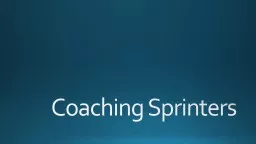PPT-Coaching Sprinters
Author : sherrill-nordquist | Published Date : 2017-01-11
Mechanics Arms control the legs 90 degree angles Drive elbows back swinging at shoulder not elbow Run tall slight lean forward Hips over knees Step over your knees
Presentation Embed Code
Download Presentation
Download Presentation The PPT/PDF document "Coaching Sprinters" is the property of its rightful owner. Permission is granted to download and print the materials on this website for personal, non-commercial use only, and to display it on your personal computer provided you do not modify the materials and that you retain all copyright notices contained in the materials. By downloading content from our website, you accept the terms of this agreement.
Coaching Sprinters: Transcript
Download Rules Of Document
"Coaching Sprinters"The content belongs to its owner. You may download and print it for personal use, without modification, and keep all copyright notices. By downloading, you agree to these terms.
Related Documents














